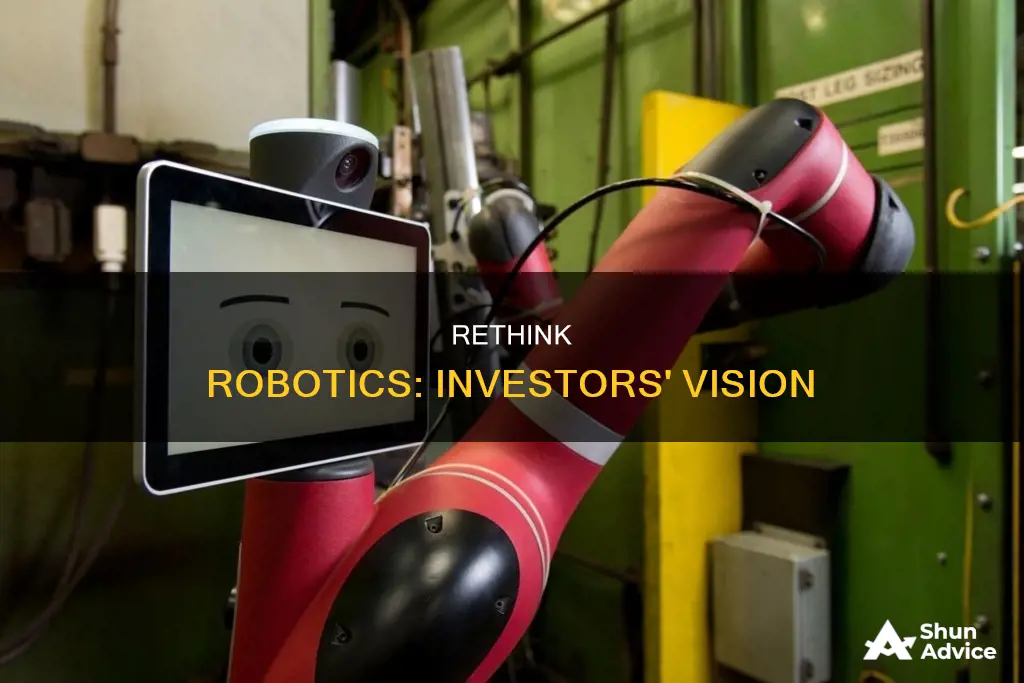
People invested in Rethink Robotics because of its innovative approach to collaborative robot technology. The company's flagship products, Baxter and Sawyer, were designed to work safely alongside human workers in various industries, including manufacturing and healthcare. These robots were marketed as low-cost, flexible, and easy to train, making them attractive to investors who recognised the potential for increased productivity and cost savings. However, despite raising $150 million from major investors and achieving initial success, Rethink Robotics ultimately failed due to design limitations and an inability to meet the needs of its target market.
| Characteristics | Values |
|---|---|
| Year founded | 2008 |
| Co-founders | Rodney Brooks and Ann Whittaker |
| Aim | Create low-cost robots |
| First robot | Baxter |
| First collaborative robot | Baxter |
| Second collaborative robot | Sawyer |
| Baxter's capabilities | Work alongside humans, be programmed to perform various tasks and serve multiple purposes |
| Sawyer's capabilities | Perform smaller, more detailed tasks |
| Baxter's price | N/A |
| Sawyer's price | $26,000 with accessories |
| Funding | $40M Series D funding round |
| Investors | Bezos Expeditions, Charles River Ventures, Highland Capital Partners, Sigma Partners, Draper Fisher Jurvetson, and Two Sigma Ventures |
| Acquired by | HAHN Group |
What You'll Learn
- Investors believed Rethink Robotics' products would improve manufacturing efficiency
- The company's robots were designed to work alongside humans, not replace them
- The robots were marketed as low-cost, safe and easy to train
- The company was co-founded by Rodney Brooks, a robot rock star
- Rethink Robotics had a successful $40M Series D funding round

Investors believed Rethink Robotics' products would improve manufacturing efficiency
Investors believed that Rethink Robotics products would improve manufacturing efficiency. The company's robots were designed to work alongside humans in factory environments, helping to optimise labour. The robots were also safe, cost-effective, and trainable, making them attractive to manufacturing companies.
Rethink Robotics' first collaborative robot, Baxter, was introduced in 2012, followed by Sawyer in 2015. Both robots could work side by side with human workers and be programmed to perform various tasks. They were based on conventional robotic arms but were smaller, slower, and less powerful, making them safer for factory floors.
The company's products aimed to bring automation to the manufacturing process, helping manufacturers meet the challenges of an agile economy. With Rethink Robotics, manufacturers could increase flexibility, lower costs, and invest in skilled labour, all while maintaining safety. The robots gave manufacturers a workforce multiplier that could handle tasks with precision and repeatability.
The investors' belief in the potential of Rethink Robotics' products is evident in the company's funding. In 2015, Rethink Robotics closed a $40 million Series D funding round, indicating strong investor confidence and financial backing for expansion and development. The company also received funding from notable investors such as Bezos Expeditions, Highland Capital Partners, and Goldman Sachs.
However, despite the initial promise of Rethink Robotics' products, the company ultimately struggled and shut its doors in October 2018. The robots' designs, which prioritised safety and cost, limited their applications and performance. They lacked the speed and precision desired by customers, and the software required to compensate for these limitations was expensive.
Investing in Startups: Where to Begin?
You may want to see also

The company's robots were designed to work alongside humans, not replace them
The robots designed by Rethink Robotics were intended to work alongside humans, rather than replace them. This collaborative approach was a key feature of the company's products, setting them apart from other robots.
Rethink Robotics' robots, Baxter and Sawyer, were created to overcome the limitations of existing robots. Typically, robots are confined to their own spaces within factories or work environments, separated from humans due to safety concerns. Baxter and Sawyer, however, were designed to be safe enough to work alongside people. They were easy to program and featured animated faces that facilitated communication with human workers.
The collaborative nature of these robots offered significant advantages in the manufacturing industry. They could work "elbow to elbow with people," as described by Julie Shah, an expert in the field of interactive robotics. This close collaboration between robots and humans presented new opportunities for automation, particularly in final assembly tasks for products like airplanes, automobiles, and electronics, which often rely heavily on human labour.
The robots' ability to work alongside humans was also enhanced by their inherent safety features. These robots were designed to minimise harm to humans, even in the event of physical contact. This aspect addressed a crucial concern in traditional factory settings, where safety measures often slow down production by requiring robots to stop or slow down when a human worker approaches.
By prioritising collaboration over replacement, Rethink Robotics created robots that could productively coexist with human workers, harnessing the strengths of both machines and people to improve efficiency and enable a more dynamic work environment.
Investing Strategies: Where to Place Your Money in a Downturn
You may want to see also

The robots were marketed as low-cost, safe and easy to train
The robots developed by Rethink Robotics were marketed as low-cost, safe and easy to train. The company aimed to create robots that could be used by manufacturers of all sizes and technology experience levels. The robots were designed to be affordable, safe to operate around people, and easy to train, requiring no programming or engineering expertise. This made them accessible to a wide range of users and helped kick-start a big trend in the robotics industry.
Baxter, the company's first collaborative robot, was introduced in 2012 and was followed by Sawyer in 2015. Both robots were designed to work alongside human workers and could be programmed to perform various tasks. They were safe to operate, with force-sensing technologies that prevented them from hurting people. This made them ideal for use in factories and other industrial settings, where they could work side-by-side with human workers to increase production and improve efficiency.
The robots were also easy to train, as they could learn tasks by being moved through them. For example, they could learn to pick objects from a conveyor belt without the need for complex programming. This made them more user-friendly and adaptable to new situations, which was a significant advantage over traditional industrial robots. The company's mission was to create a new kind of manufacturing robot that could introduce robotics into processes that were previously too costly or complex to automate.
Rethink Robotics' focus on low-cost, safe, and easy-to-train robots helped differentiate them from other robot manufacturers and attracted the interest of investors. The company had some big-name backers, including GE Ventures, Highland Capital, and Bezos Expeditions, reflecting the potential that investors saw in their technology. However, despite their innovative approach and strong technical pedigree, Rethink Robotics ultimately ceased operations in 2018 due to low sales and financial challenges.
Tomorrow's Investments: Where to Look
You may want to see also

The company was co-founded by Rodney Brooks, a robot rock star
Brooks is known for popularizing the actionist approach to robotics, which suggests that action or behaviour, rather than computation, is a more appropriate conceptual metaphor for robotics. This approach is particularly relevant for robots that need to accomplish everyday tasks in environments shared by humans. In 1997, Brooks introduced a robot named Allen, which used subsumption architecture. Brooks has also experimented with off-the-shelf components, such as Fischertechnik and Lego, to create self-replicating robots.
Rethink Robotics, formerly known as Heartland Robotics, was founded with the goal of creating low-cost robots. The company released its first collaborative robot, Baxter, in 2012, followed by Sawyer in 2015. These robots were designed to work alongside humans in factory environments and could be programmed to perform various tasks. The robots included features such as stopping when encountering a human in their path and having a prominent off switch for safety.
In 2016, Rethink Robotics released their collaborative robots worldwide, showcasing their ability to work in tandem with humans rather than replacing them. The company's innovative approach to robotics and Brooks' reputation as a robotics pioneer likely contributed to the attraction of investors.
Fear of Losing Money Keeps People from Investing
You may want to see also

Rethink Robotics had a successful $40M Series D funding round
Rethink Robotics, a company that develops collaborative, trainable robots for manufacturing companies, had a successful $40M Series D funding round. This funding round is a strong indicator of investor confidence and financial backing for expansion and development. The company's robot, Baxter, is recognised for its capabilities, suggesting product recognition and potential market penetration.
Rethink Robotics was founded in 2008 as a startup aiming to create low-cost robots. In 2012, they introduced their first collaborative robot, Baxter, which could work alongside human workers and be programmed to perform various tasks. In 2015, they released a smaller and more flexible counterpart to Baxter, Sawyer, which was designed for smaller, more detailed tasks. Both robots prioritised safety and cost over speed and precision, making them ideal for working alongside humans in factory environments.
The successful Series D funding round for Rethink Robotics demonstrates that investors recognised the potential of the company's innovative technology and its ability to bring automation to the manufacturing process. The funding will likely be used to expand the business and further develop its products, solidifying its position in the market and driving continuous innovation.
The funding round also highlights the potential of collaborative robots in the industry. By working alongside human workers, these robots can optimise labour, increase flexibility, and lower costs for manufacturers. The success of Rethink Robotics' funding round underscores the confidence in their technology and its ability to revolutionise the manufacturing industry.
Investing in Movies: How to Get Started
You may want to see also
Frequently asked questions
People invested in Rethink Robotics because of its innovative approach to creating low-cost, collaborative robots that could work safely alongside humans in factory environments. The company's successful closure of a $40M Series D funding round demonstrated investor confidence and financial backing for its expansion and development.
Rethink Robotics' robots, such as Baxter and Sawyer, were designed to be easy to set up, trainable, and safe for use alongside human workers. They could also perform a variety of tasks and serve multiple purposes, making them versatile and adaptable for manufacturers.
Rethink Robotics prioritized safety and cost over speed and precision. Their robots used series elastic actuators, which were cheaper and safer but less accurate than conventional positioning systems. This made them ideal for markets where precision wasn't a primary concern, such as machine tending.
Rethink Robotics faced challenges in meeting the needs of its target market, which consisted primarily of small- and medium-sized manufacturers. Their designs, particularly the two-armed Baxter, were not as well-received as they had hoped, and the company struggled to compete with rivals like Universal Robots, which offered more accurate and repeatable robots.







